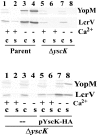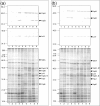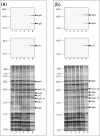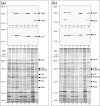Growth of calcium-blind mutants of Yersinia pestis at 37 degrees C in permissive Ca2+-deficient environments
- PMID: 19443541
- PMCID: PMC2888125
- DOI: 10.1099/mic.0.028852-0
Growth of calcium-blind mutants of Yersinia pestis at 37 degrees C in permissive Ca2+-deficient environments
Abstract
Cells of wild-type Yersinia pestis exhibit a low-calcium response (LCR) defined as bacteriostasis with expression of a pCD-encoded type III secretion system (T3SS) during cultivation at 37 degrees C without added Ca(2+) versus vegetative growth with downregulation of the T3SS with Ca(2+) (>or=2.5 mM). Bacteriostasis is known to reflect cumulative toxicity of Na(+), l-glutamic acid and culture pH; control of these variables enables full-scale growth ('rescue') in the absence of Ca(2+). Several T3SS regulatory proteins modulate the LCR, because their absence promotes a Ca(2+)-blind phenotype in which growth at 37 degrees C ceases and the T3SS is constitutive even with added Ca(2+). This study analysed the connection between the LCR and Ca(2+) by determining the response of selected Ca(2+)-blind mutants grown in Ca(2+)-deficient rescue media containing Na(+) plus l-glutamate (pH 5.5), where the T3SS is not expressed, l-glutamate alone (pH 6.5), where l-aspartate is fully catabolized, and Na(+) alone (pH 9.0), where the electrogenic sodium pump NADH : ubiquinone oxidoreductase becomes activated. All three conditions supported essentially full-scale Ca(2+)-independent growth at 37 degrees C of wild-type Y. pestis as well as lcrG and yopN mutants (possessing a complete but dysregulated T3SS), indicating that bacteriostasis reflects a Na(+)-dependent lesion in bioenergetics. In contrast, mutants lacking the negative regulator YopD or the YopD chaperone (LcrH) failed to grow in any rescue medium and are therefore truly temperature-sensitive. The Ca(2+)-blind yopD phenotype was fully suppressed in a Ca(2+)-independent background lacking the injectisome-associated inner-membrane component YscV but not peripheral YscK, suggesting that the core translocon energizes YopD.
Figures









References
-
- Brubaker, R. R. (1967). Growth of Pasteurella pseudotuberculosis in simulated intracellular and extracellular environments. J Infect Dis 117, 403–417. - PubMed
Publication types
MeSH terms
Substances
Grants and funding
LinkOut - more resources
Full Text Sources
Miscellaneous

